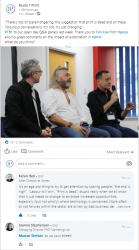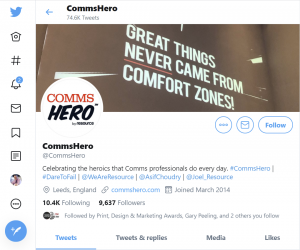Many printers have dabbled in social media in the hope that it would help drive sales, only to get disappointing results. Andy Knaggs looks at how some printers are adapting their mindset to make social media marketing a success
Notoriety comes in all shapes and sizes, as Asif Choudry, sales and marketing director at Leeds printer Resource discovered recently when he attended a client event. He was introduced to an executive of the client organisation who, when told that Mr Choudry was from Resource, exclaimed, ‘You’re the custard cream guys!’
It is not such a bad thing to be remembered for. After all, there are many who see the custard cream as a prince among biscuits. For Mr Choudry though, it is further confirmation that Resource’s approach to customer engagement is cutting through, and within that approach the use of social media is a key component. Resource sends its customers and prospects a calendar every year, as many printers probably do. The purpose of the calendar, however, is not just to give these companies a useful physical record of upcoming events. Its purpose is to start a conversation about that most mundane of things: dunking biscuits in hot beverages.
Using #dunkability on its Twitter and LinkedIn accounts, Resource follows up on the calendar with an ongoing campaign of social media posts that draw in recipients
to voice their own opinions on what biscuit is best to dunk, and engage with a series of fun challenges such as designing their dream biscuit.
‘It’s creating warmth with customers, and that’s where social media can make a tangible difference,’ said Mr Choudry. Resource is a leading exponent of social media amongst UK printers, according to marketing consultant Jacky Hobson of Up Marketing, who has worked for years with British printers, helping them to market themselves better.
‘They are a class act when it comes to their social media,’ she said. ‘They have really got the tone of voice right and they are engaging with their customers, sometimes about print, sometimes about things that are far more of a personal nature. I would say they are the best example of a printer using social media.’
 Being social
Being social
The key to Resource’s approach to social media is that the company understands how the medium should be used. There is a clue in the term ‘social media’ itself – it is supposed to be social, and in a social environment people do not want to be overtly sold to. However, they are often happy to engage, either with light-touch, light hearted content, or with business insight or intelligence that informs them and which, by sharing, enhances their own standing in the B2B social media community.
Ms Hobson continued, ‘The businesses that get social media wrong see it as a broadcast medium and you can see that on any number of printers’ sites – get your business cards for X pounds. Really, the chances of that resonating with someone are very small. I don’t think you can use it to measure sales, it just has to be part of your strategy. It’s much less about talking and much more about listening.’
It is true however that many printers have dabbled in social media and do not feel they have cracked it. In researching this article, one printer with a successful online brand told Digital Printer that his company has tried on quite a few occasions to achieve lift-off with social media, with ‘mixed, and at best limited success’. He said, ‘I’m sorry to say that B2B marketing on any of the social media platforms we’ve tried has proved to be less effective than we had hoped or envisaged.’ As a result, social media is now addressed there on an ad hoc basis.
That is not going to cut it, according to Asif Choudry. ‘It is critical that you are active frequently in the social media space, posting, sharing, commenting, generally being part of the conversation, if not leading it. This might not be natural for many people, and they will often feel even less inclined if they are already ‘too busy’.
Social media requires commitment, and to give readers an idea of the degree of that commitment, Mr Choudry explains how Resource views its social media activity. ‘It
has completely changed the way we keep in contact with clients. We have lots more conversations that are not part of a transaction. Before social media, we just rang and said, have you got any work you need printing? Now we can speak to them seven days a week, interact with them, and connect them to other customers and influencers.
‘It is hard to measure, and you have to put a lot in personally, but if it did not bring any business in, we would not do it. I have seen printers set up on Instagram and post things that they have printed, and then wait for the sales to follow. That’s not going to do anything, to be honest. People have to realise that you have got to invest the time; it’s not one hit, you’ve got to get the conversation going on a regular basis.
‘Nor is it about bringing in a digital marketing manager or a digital apprentice; these people are not trained in sales conversations. We report on interactions on social media with clients in our sales meetings, just as you would with normal sales calls.’
To say this approach to business development might require patience would be an understatement. Mr Choudry admits that he has engaged with people on social media for three years before he has even met them. You have to be prepared to accept that any interaction via social media might lead to no business at all, but still be prepared to play the long game, keep engaging for engagement’s sake, with the goal of developing a soon-to-be fruitful business relationship.

Resource does monitor this activity by its sales team, in the same way that any business expects to hear feedback from a salesperson tasked with making 20 calls day. While it does not demand a set number of posts per day by its sales employees, it does measure the quantity of social interactions because it wants these employees to get into the habit of being active on social media.
‘It’s good, old-fashioned sales – you’ve got to play the numbers game, and we will share the numbers across calls, social media interactions and meetings,’ said Mr Choudry.
Generation game
Resource is by no means the only printer that is having a positive experience with social media. Given its youthful but sky-rocketing profile in the industry, it is probably no surprise to hear that Route 1 Print is an experienced social media player.
‘We use social media to drive new business, but it is more lead generation-based than sales,’ explained marketing team leader Christie Round. ‘Our brand value is to support the lives of creatives and printers so, for prospects who don’t know the brand, we want to create that relationship. Social media helps us do that through being there and offering advice and tools for their business. Social media is also a place where we get feedback on the content pieces we create, and that level of engagement is something you cannot buy.
‘I think in today’s world, customers want to feel aligned with your brand, and it is more about how available you are and if you are there on the channel they want to speak to you on.’
A much smaller company than either of these two organisations is Ripe Digital in Corsham, Wiltshire, which has LinkedIn, Facebook and Instagram platforms for sharing content. George Penny, account manager at the company, says the aim of its social media activity is to ‘provide inspiration’.
‘This could be an insight into how we work, the equipment that’s been used, material, a finishing process or a creative solution. Sometimes it’s just a case of ‘wow, that job
turned out really nice let’s show everyone!’. Ultimately, it’s about trying to ensure people know what we are capable of producing, and that they keep us in mind for future
projects. We don’t have a dedicated sales team, and social media is our way of reaching out, so it needs to do the talking for us.’

Channel hopping
If you are not sure which social media channel is the right one to use, the best guide is to identify which ones your customers or prospective customers are using, says
Charlotte Sheridan, director at The Small Biz Expert. ‘It’s important to remember that no channel is a magic sales channel,’ she continued. ‘Social media should be used to
nudge potential customers along a journey to purchase, and should target all stages of a buyer’s process. It’s also important to note that awareness is part of the sales process, and probably the one that organic social media does best.’
Another marketer – former DST and Paragon executive Fraser Church, now general manager of print co-operative CPX Group – describes social media as ‘a nice way to do light-touch marketing’, adding, ‘It’s more for story-telling. Trying to use it for hard-nosed selling is very difficult, but connecting people to the brand, yes. It helps spread conversation and interest. It’s probably the softer side of selling.’
Used skilfully, social media can help printers to develop relationships and keep their name in the minds of the buying community. It is a more relaxed environment where business people share information and have a little fun along the way. If printers can engage with it on those terms, hold back from the hard sell and join in the conversation, it can work to their advantage.





